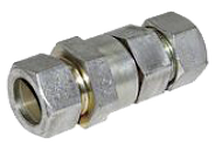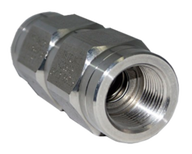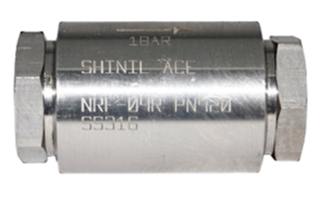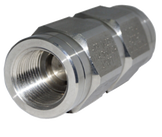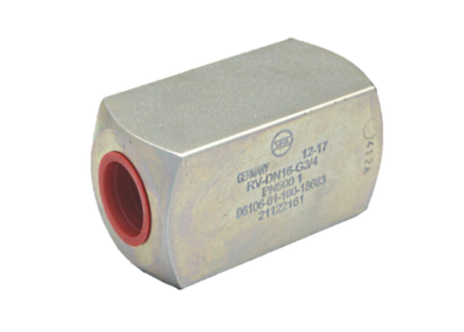|
|
High pressure check valves are forms of valves that allow the flow of fluids in the hydraulic system to pass through one direction. They are installed in a hydraulic system as a valve that prevents backflow. They are also referred to as non-return valves. The high pressure check valve uses the National Pipe Thread Tapered (NPT) and British Standard Pipe (BSPP) connection types. They are available in different sizes ranging from 1/4” to 2” or DN8 to DN50. The valve can withstand working pressure up to 420 bar and is made of stainless steel or steel. There are many types of check valves such as swing check valve, ball check valve, lift check valve, wafer check valve, etc. Check valves are very flexible and have a working temperature of a maximum of 150⁰C. |
Material Specification |
|
Connection Type |
|
Size |
|
Working Pressure |
|
1. What is a Check Valve used of?
|
High pressure check valves are valves designed with two openings in one body. These openings serve the purpose of influx and outflow of fluids. These valves are commonly used in household tools and also available for use in various industries. Check valves are made from carbon steel and stainless steel materials and work with a pressure of a maximum of 420 Bars.
The check valve has five parts which are the body, spring, seat, o-ring, and disc. Also, check valves use the threaded end connection type. This follows the standard of British Standard Pipe Parallel (BSPP) or National Pipe Thread (NPT). Further, the working temperature ranges from -54⁰C – 150⁰C. This level of temperature depends on the material used for the o-ring while the installation of the valve was done. They are produced with stainless steel (AISI 316) or Steel (EN-10277-3). |
2. How does a High Pressure Check Valve work?
Check valves are commonly installed in systems that can’t accommodate backflow as they allow flow in just one direction. It uses a pressure differential to work, that is, the pressure on the inner side is more than the outer side when the valve opening is done. Peradventure, there's insufficient pressure for the inner side, the valve closes. However, they differ from other valves as they operate without handles, actuators, levers, or workforce.
|
A check valve has a closing position that works with the presence of cracking pressure. Cracking pressure is defined as the minimum upstream pressure, which allows the valve to open and makes the passage of fluid in one direction possible. The cracking pressure of each check valve is based on specifications like the design and size of the valve. However, the general cracking pressure for check valves is between 0.5 to 1 bar. Higher cracking pressure valves can be designed upon request. The minimum of the specified working pressure for the valves is required to ensure the efficiency of the check valve.
To ascertain the correct installation of the check valve, an arrow stamp is included on the body which indicates the points for the inlet and outlet of fluids for the valve. |
3. Do I need a High Pressure Check Valve?
The versatility of high pressure check valves is due to the availability of various types designed to fit into different applications. High pressure check valves are used in the following system/industries:
- Industries: several industries use check valves. In the aero industry, check valves are placed in areas with high vibration and corrosive fluids such as hydraulic systems, Attitude Control Systems (ACS), etc.
|
Also, check valves used in nuclear systems are applied in make-up water, dump lines, N2 systems, etc. Furthermore, check valves are used in the oil and gas industry to prevent gas mixing from the primary store. Other areas of applications are the petrochemical industry and HVAC systems, etc.
|
Generally, check valves are beneficial as they help prevent water hammering and remove the probability of valve failure due to their extreme flexibility.
4. How does High Pressure Check Valve work?
|
For the perfect fitting of the check valves, follow these simple steps:
|
5. What type of valve is Check Valve?
There are many types of check valves. These different types are applied in various systems and industries, some of these are:
Other types of high pressure check valves are tilting disk check valves, Duo-check valves, disk check valves, piston check valves, and non-slam check valves.
- Swing Check Valve: a swing check valve is automatic valves mostly applied in pipelines for the fluid to flow through one direction. The parts of the swing check valve are the valve body, disk, and bonnet all connected to a hinge. The swing valve swings to the back of the valve seat which leads to forwarding flow or towards the seat to block flow. The valve is produced in many designs which make it suitable for many applications. The valve operates automatically and shuts off when the pressure level reaches zero.
- Lift Check Valve: a lift check valve has a ball-like or piston-like disc which is fitted into a dashpot. They can be installed in horizontal or vertical pipelines and accommodates high-pressure machines.
- Ball Check Valve: Ball Check valves are mostly used for small pumps like water and wastewater systems. The inner part of a ball check valve has a ball that swings back and forth. It has a conical chamber with the seat attached to the ball.
- Wafer Check Valve: Wafer check valves are small-sized valves with disc and seat. Due to its compact size, wafer check valves are suitable to be fit in-between sets of flanges. They can be installed horizontally or vertically and used in many industries such as mining, power plants, swimming pools, tanks, etc.
Other types of high pressure check valves are tilting disk check valves, Duo-check valves, disk check valves, piston check valves, and non-slam check valves.
HIGH PRESSURE CHECK VALVES CATALOGUE

